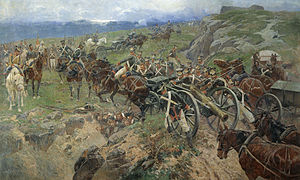Karyagin's Raid
| Karyagin's Raid | |||||||
|---|---|---|---|---|---|---|---|
| Part of Russo-Persian War (1804-1813) | |||||||
 Franz Roubaud's painting "The Living Bridge". Episode of the transition of the Russian detachment from Shakhbulag to Mukhrat. | |||||||
| |||||||
| Belligerents | |||||||
|
|
| ||||||
| Commanders and leaders | |||||||
|
|
| ||||||
| Strength | |||||||
|
400 men 2 guns[1] | 30,000 (pick)[2] | ||||||
| Casualties and losses | |||||||
| Very Heavy | Unknown | ||||||
Colonel Karyagin's campaign (Russian: Поход Полковника Карягина) (In Iranian sources known as Qarabagh-Ganjeh campaign) are the actions of a small Russian detachment in order to gain time against the Persian army. He completely coped with this task, although most of the squad was killed or wounded.
Background
[edit]In 1805, the Treaty of Kurakchay was concluded, according to which Russia annexed Karabakh. However, at the same time, dramatic events were taking place in Europe. Russia took an active part in them, and therefore could not maintain large forces in the Caucasus. The Iranians planned to take advantage of this and return the territory of Karabakh. To do this, they tried to raise 100,000 troops.[3] To counter them, Tsitsianov gathered two detachments - Lenevich and Karyagin, Lenevich's detachment was already able to defeat the Persians once,[4] Karyagin was preparing to march at that time.
Campaign
[edit]Karyagin marched on June 21, and three days later, on the outskirts of Shah Bulakh, he was attacked by a detachment of 3,000 Persians, The Russians successfully repelled the attack, but lost 197 people.[5][a] On the same day, he wrote a letter to Tsitsianov:
Neglecting the number of Persians, I would have made my way to Shusha with stakes, but the great number of wounded people, whom I do not have the means to raise, makes it impossible for any attempt to move from the place I occupied.[7]
On June 28, Abbas Mirza launched a new attack with 15,000 army, Russians were successfully defence for a whole day, but Lieutenant Lisenko's detachment and 32 soldiers betrayed Karyagin and sided with the Persians, this inspired them and they launched a new attack, which the Russians also repelled,[6] the death toll rose to 90.[2] Deserters appeared in the squad. However, he had some good news, a small detachment made a sortie and seized supplies in the Persian camp,[7] and the main part of the army captured Shah Bulah castle and exterminated its garrison.[6] New forces were coming to the Persians, and Karyagin decided to buy time so that Tsitsianov could gather troops and begin negotiations and capitulations. They gained time and were able to escape from the Iranian army at night.[2] The Persians saw this stumble and sent advanced detachments forward, but Karyagin repelled them without loss and arrived in Elisavetpol on July 22.[6] However, Abbas Mirza attacked the remnants of Karyagin's army, who did not have time to come to the city, the Persian army reached 30,000. Karyagin gathered 570 people and completely defeated the Iranians, thereby securing Tiflis.[7] After that, he joined up with Tsitsianov.[8]
Aftermath
[edit]Karyagin's expedition was a huge success, it thwarted all the plans of the Persians to attack Georgia and Karabakh, bought time for the Russians to attack again, perhaps this is the most important operation of the war.[7]
Memory
[edit]The cemetery is now open to the participants of the raid. Karyagin himself received the Order of St. George and the golden sword personally from the tsar.[7] ==Reference=+
- ^ Егоршина 2023, p. 493.
- ^ a b c Bournoutian 2021, p. 117.
- ^ Bournoutian 2021, p. 114.
- ^ Егоршина 2023, p. 494.
- ^ Bournoutian 2021, p. 116.
- ^ a b c d Егоршина 2023, p. 495.
- ^ a b c d e Potto 1889.
- ^ Bournoutian 2021, pp. 117–118.
Bibliography
[edit]- Bournoutian, George (2021). From the Kur to the Aras. A Military History of Russia’s Move into the South Caucasus and the First Russo-Iranian War, 1801—1813. Iranian Studies, Volume 22. Brill. ISBN 978-90-04-44515-4.
- Егоршина, Петрова (2023). История русской армии [The history of the Russian Army] (in Russian). Moscow: Edition of the Russian Imperial Library. ISBN 978-5-699-42397-2.
- Potto, Vasily (1889). Кавказская война: Подвиг полковника Карягина [Caucasus war: the feat of Colonel Karyagin] (in Russian).
